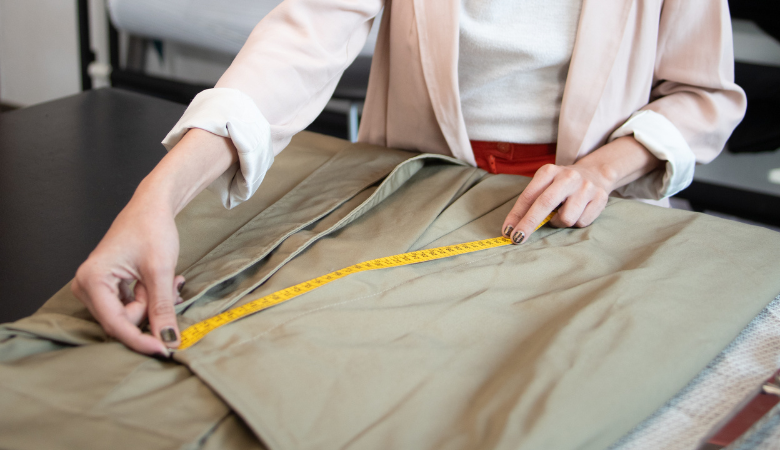
You know how fast trends shift in the textile industry. Textiles quality control now feels more important than ever, especially with new textile industry trends shaping every step. If you want to see real improvement, you need to use proven textiles quality control methods. Quick action brings measurable results. Every step you take in textiles quality control pushes your products ahead. Stay alert to trends and focus on quality. You drive improvement when you keep textiles quality control at the heart of every process.

Key Takeaways
• Use digital monitoring and real-time data to catch and fix quality issues quickly during production.
• Apply AI and high-tech sensors to detect defects early and keep quality consistent without relying only on human checks.
• Create clear standard operating procedures and perform regular inspections to maintain consistent quality control.
• Train your team regularly and update them on new quality standards to keep everyone skilled and ready for changes.
• Work closely with suppliers and set clear material specifications to ensure high-quality fabrics from the start.
Digital Monitoring in Textiles Quality Control
Real-Time Data
You want to catch problems before they turn into big issues. Real-time data gives you that power. When you use digital monitoring, you see every step of your production process as it happens. This means you can spot mistakes in printing or weaving right away. You do not have to wait until the end of the line to check for errors. You can fix them on the spot. This saves you time and keeps your quality high.
Tip: Set up digital sensors on your machines. These sensors track things like color consistency, fabric tension, and even the speed of digital fabric printing. You get alerts if something goes wrong. You can act fast and keep your quality control strong.
You also get a clear record of every batch. If a customer asks about a problem, you can show them exactly what happened. This builds trust and helps you improve your process.
Predictive Analytics
Now, let’s talk about going one step further. Predictive analytics uses data from your machines and past production runs to predict future problems. You do not just react to issues—you prevent them. For example, if your system notices a pattern of small defects in tech-enhanced fabrics, it can warn you before the defects get worse.
• Predictive analytics helps you:
◦ Reduce waste by catching issues early
◦ Improve printing results by adjusting settings before errors appear
◦ Keep your quality control process smooth and reliable
IoT connectivity makes this even better. Your machines talk to each other and share data. You get a full picture of your quality, from digital fabric printing to final inspection. You stay ahead of problems and keep your quality high at every stage.
Remember: Digital monitoring and analytics are not just for big factories. You can start small and scale up as you see results. Reliable textiles quality control starts with smart data and quick action.
AI and Advanced Testing
Defect Detection
You want to catch defects before they reach your customers. AI makes this possible. With smart cameras and machine learning, you can spot even the smallest defects in your textiles. These systems scan every inch of fabric. They find issues like color streaks, holes, or uneven patterns. You do not have to rely only on human eyes. AI works faster and does not get tired.
AI-powered defect detection helps you keep your quality high. You can set up alerts when the system finds defects. This lets you stop the line and fix problems right away. You save time and reduce waste. Your quality control process becomes more reliable. You also build trust with your customers because you deliver better products.
Tip: Use AI systems to track patterns in defects. You can find out if certain machines or materials cause more problems. This helps you improve your process and keep your quality at its best.
High-Tech Sensors
High-tech sensors take your quality control to the next level. These sensors check things like fabric thickness, color, and strength. You get real-time feedback on your production line. If a sensor finds a problem, you can act fast. This keeps your quality steady from start to finish.
You can use sensors for tech-enhanced fabrics too. These fabrics need special care. Sensors help you control every detail. You make sure your products meet the highest standards. Your team can focus on fixing issues instead of searching for them.
• Benefits of high-tech sensors:
◦ Faster detection of defects
◦ Better control over quality
◦ Less waste and higher efficiency
You want your quality control to be strong and smart. AI and advanced testing tools give you that edge. You stay ahead of defects and keep your quality high every day.
SOPs and Inspections
Standard Operating Procedures
You want your textiles quality control to run smoothly every day. Standard operating procedures (SOPs) help you do that. SOPs give your team clear steps to follow for every task. When you set up SOPs, you make sure everyone knows the right way to check quality. You create a routine that keeps your quality high and your process consistent.
You should write down your quality standards in detail. Make sure your team understands what counts as a defect and what meets your standards. Use checklists so no step gets missed. When you update your SOPs, you keep up with new quality standards and industry changes. This helps you avoid mistakes and keeps your control process strong.
Tip: Review your SOPs with your team often. Ask for feedback and make changes when you spot gaps. This keeps your quality control sharp and up to date.
Regular Inspections
Inspections keep your quality on track. You need more than just one check at the end. Use a multi-stage inspection approach. Start with a pre-production inspection to catch problems before production begins. Then, use in-line inspection during production to spot issues early. Finish with a final inspection before shipping.
Here’s a simple inspection schedule you can follow:
| Stage | Type of Inspection | Purpose |
|---|---|---|
| Before Production | Pre-production | Check materials and standards |
| During Production | In-line | Monitor ongoing quality |
| End of Production | Final | Ensure finished product meets quality standards |
Random inspections add another layer of control. You can do random inspections at any stage to catch hidden issues. This keeps your team alert and your quality high. Stick to your inspection protocols and always compare results to your quality standards.
Remember: Regular inspections and strong SOPs work together. They help you meet quality standards every time.
Staff Training for Quality Control
Upskilling Teams
You want your team to feel confident about quality control. Training helps everyone understand what quality means for your products. When you upskill your team, you give them the tools to spot issues early. You also help them learn new ways to keep quality high. Training sessions can cover topics like fabric inspection, machine operation, and safety rules.
You can use different methods to train your team. Try hands-on workshops, short videos, or even quick quizzes. Mix things up to keep everyone interested. When your team learns together, they share tips and support each other. This teamwork leads to better quality and fewer mistakes.
Tip: Set up regular training sessions. Make learning part of your routine. This keeps everyone focused on quality control and encourages continuous improvement.
Adapting to New Standards
The textile industry changes fast. New standards for quality appear all the time. You need to help your team stay up to date. Share updates about new rules or testing methods. Use simple guides or checklists so everyone knows what to do.
Here’s a quick way to help your team adapt:
| Step | Action |
|---|---|
| 1 | Review new quality standards |
| 2 | Update training materials |
| 3 | Practice new procedures |
| 4 | Give feedback and improve |
Encourage your team to ask questions. Open communication leads to improvement. When you focus on continuous improvement, your team feels ready for any change. You build a culture where quality control is always a top priority.
Remember: Training is not a one-time event. Keep learning and adapting. This helps you reach higher levels of quality and control every day.
Supplier Management and Material Quality
Vetting Suppliers
You want your textiles to meet high standards every time. That starts with choosing the right suppliers. When you vet suppliers, you check their track record for quality. You ask for samples and review their testing reports. You visit their facilities if possible. You look for suppliers who follow strict quality control steps. This helps you avoid surprises later.
Here’s a simple checklist you can use when vetting suppliers:
• Ask for recent quality certificates.
• Review their quality control process.
• Check how they handle complaints.
• Request references from other clients.
Tip: Build strong relationships with your suppliers. Open communication helps you solve problems fast and keeps your quality high.
Material Specifications
You need clear material specifications to keep your quality consistent. Write down the exact standards for every fabric you use. Include details like fiber content, colorfastness, and strength. Share these specs with your suppliers. Make sure they understand your quality expectations.
Set up a routine to test incoming materials. Use your quality control team to check samples before production starts. If a batch does not meet your specs, you can stop it before it affects your products. This step gives you more control over your final quality.
• Benefits of clear material specs:
◦ Fewer defects in finished products
◦ Easier communication with suppliers
◦ Stronger quality control at every stage
Remember: Good supplier management and clear material specs make your quality control process much easier. You get better results and happier customers.
Sustainable Practices in Quality
Eco-Friendly Standards
You see more customers asking about sustainability every year. They want to know that your textiles meet eco-friendly standards. You can set yourself apart by making sustainability a core part of your quality process. Start by reviewing your current quality standards. Update them to include requirements for sustainable fabrics and responsible production.
You might use a checklist like this to keep your team on track:
• Use certified sustainable fabrics in your production.
• Limit water and energy use during printing.
• Follow strict waste management standards.
• Test for harmful chemicals to meet global quality standards.
You can also set up regular reviews of your eco-friendly standards. This helps you stay ahead of new rules and customer expectations. When you focus on sustainability, you show your commitment to both quality and the environment.
Tip: Share your updated quality standards with your suppliers. This helps everyone work toward the same sustainability goals.
Traceability
You want to prove that your textiles meet high quality standards. Traceability gives you that power. You track every step, from raw material to finished product. This means you can answer questions about where your materials come from and how you meet quality standards at each stage.
A simple table can help you organize your traceability process:
| Step | What to Track | Why It Matters |
|---|---|---|
| Raw Materials | Source, certifications | Meet sustainability standards |
| Production | Printing, inspections | Maintain quality standards |
| Shipping | Batch numbers, records | Ensure quality on delivery |
You build trust when you can show this information. Customers see your commitment to quality and sustainability. You also make it easier to fix problems if they come up. Traceability supports your quality goals and helps you meet strict standards in every batch.
Testing Protocols and Audits
Standardized Testing
You want your textiles to meet the highest standards every time. Standardized testing gives you a clear path. When you use the same tests for every batch, you know your results are reliable. You can check for colorfastness, strength, and shrinkage. These tests help you spot problems before your products reach customers.
Start by setting up clear quality standards. Write down what you expect for each product. Use simple language so your team understands. Create a checklist for every test. This keeps your process organized and easy to follow.
Tip: Review your testing protocols often. Update them when industry standards change. This helps you stay ahead and keeps your quality strong.
You can also use a table to track your results:
| Test Type | Standard Value | Result | Pass/Fail |
|---|---|---|---|
| Colorfastness | 4-5 | 5 | Pass |
| Strength | 300N | 310N | Pass |
| Shrinkage | <3% | 2.5% | Pass |
This table makes it easy to see if your textiles meet your quality standards.
Internal and External Audits
Audits keep your quality control sharp. You can run internal audits with your own team. These checks help you find gaps in your process. You can fix problems before they grow. External audits bring in outside experts. They give you a fresh look at your quality and standards.
Set up regular inspection schedules. Use inspection protocols that match your quality standards. Include random inspections to catch hidden issues. When you follow a routine, you keep your control process strong.
Remember: Clear guidelines and regular audits help you build trust with your customers. You show that you care about quality at every step.
Customer Feedback and Market Data
Feedback Loops
You want to keep your quality high, so you need to listen to your customers. Feedback loops help you do this. When you collect feedback, you see how your products perform in real life. You spot new trends before they become big. You can use surveys, online reviews, or direct calls to gather opinions. Every comment gives you a chance to improve your quality.
Set up a simple system to track feedback. Try a table like this:
| Feedback Source | Common Issues | Action Taken |
|---|---|---|
| Online Reviews | Color fading | Adjust dye process |
| Customer Calls | Loose threads | Extra inspection |
You close the loop when you act on feedback. You show customers that you care about quality. You also stay alert to textile industry trends. This helps you adjust your process and keep up with changing trends.
Tip: Share feedback results with your team. Everyone learns from real customer experiences. You build a culture that values quality and quick action.
Responding to Textile Industry Trends
You see new textile industry trends every season. Some trends focus on eco-friendly fabrics. Others highlight bold prints or tech-enhanced materials. You need to respond fast if you want to stay ahead. Watch market data and social media to spot trends early. You can use this information to guide your quality checks and inspection routines.
Here’s how you can stay on top of trends:
• Track textile industry trends with regular market research.
• Update your quality standards to match new trends.
• Train your team on the latest textile industry trends.
• Adjust your inspection process for new materials or designs.
You keep your quality strong when you follow trends closely. You also build trust with customers who want the latest styles. Textile industry trends shape your quality goals, so stay curious and ready to adapt.
Note: Trends change quickly. Stay flexible and review your quality process often to keep up with textile industry trends.
On-Demand and Lean Manufacturing
Flexible Quality Control
You want to keep up with fast changes in the textile market. On-demand manufacturing helps you do that. You only produce what your customers need, when they need it. This approach means you must have flexible quality control. You cannot wait for long checks at the end of production. You need to check quality at every step.
Set up checkpoints during each stage. For example, inspect fabric after weaving, before printing, and before shipping. This way, you catch problems early. You save time and reduce waste. Your team can fix issues right away. You keep your quality high, even when orders change quickly.
Tip: Use digital tools to track each batch. You get real-time updates and can adjust your control process as needed.
Lean Production
Lean production focuses on doing more with less. You cut out steps that do not add value. You keep your process simple and clear. This method helps you improve quality and reduce costs at the same time.
Here are some ways to use lean production in textiles:
• Organize your workspace to avoid confusion.
• Train your team to spot waste and fix it fast.
• Use a table to track defects and solutions:
| Problem Found | Solution Used | Result |
|---|---|---|
| Loose threads | Extra trim | No defects |
| Color mismatch | Adjust dye | Improved |
You want your quality control to fit lean production. Focus on what matters most. Check only the key points that affect quality. This keeps your process fast and your products reliable.
Remember: Lean production and flexible control help you meet customer needs and keep your quality strong.
You have seen how strong textiles quality control keeps you ahead. Stay alert to textile industry trends and use them to guide your next steps. Try new methods, track trends, and focus on continuous improvement. Every small improvement helps you respond to trends faster.
Take action now. You can future-proof your business by following these proven steps and staying ready for the next wave of textile industry trends.
FAQ
What is the most important step in textiles quality control?
You need to set clear quality standards first. This step guides every other part of your process. When you know what to look for, you can spot problems early and fix them fast.
How often should you update your quality control procedures?
You should review your procedures at least once a year. If you see new trends or rules in the textile industry, update your process sooner. Staying current helps you keep your quality high.
Can small textile businesses use digital monitoring?
Yes! You can start with basic sensors or simple software. Even small changes help you catch issues early. As your business grows, you can add more advanced tools.

Smart Sourcing & Quality Assurance Content Team
Article by Smart Sourcing & Quality Assurance Content Team
The Smart Sourcing & Quality Assurance Content Team is dedicated to delivering high-quality, easy-to-understand information that empowers our audience to navigate the complexities of global sourcing and quality assurance. Our team of writers has extensive experience in creating content across various fields, including procurement, supply chain management, quality assurance, market trends, and industry best practices. We specialize in sectors such as apparel, textiles, and consumer goods, providing targeted insights to help businesses in these industries optimize their sourcing strategies, ensure product quality, and maintain a competitive edge in the market.


